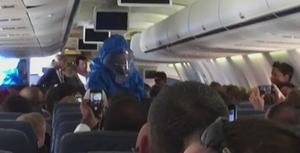EbolaU.S. will see between 1 and 130 additional Ebola cases by end of 2014: Experts
Top U.S. medical experts studying the spread of Ebola predict a few more cases will reach America before year’s end, citing the return of healthcare workers currently working in West Africa as the most likely cause of new cases. Using data models that weigh several variables including daily new infections in West Africa, global airline traffic, and transmission possibilities, top infectious disease experts predict as few as one or two additional infections and as many as 130 by the end of 2014.

Several health worker in protective garb board airplane to screen passenger // Source: goldmarketplaza.com
Top U.S. medical experts studying the spread of Ebola predict a few more cases will reach America before year’s end, citing the return of healthcare workers currently working in West Africa as the most likely cause of new cases. Using data models that weigh several variables including daily new infections in West Africa, global airline traffic, and transmission possibilities, top infectious disease experts predict as few as one or two additional infections and as many as 130 by the end of 2014. “I don’t think there’s going to be a huge outbreak here, no,” said Dr. David Relman, a professor of infectious disease, microbiology and immunology at Stanford University’s medical school. “However, as best we can tell right now, it is quite possible that every major city will see at least a handful of cases.”
Dominic Smith, a senior manager for life risks at Newark, California-based RMS, a leading catastrophe-modeling firm, shared with the AP results from a U.S. simulation that projected fifteen to 130 cases between today and end of December. Smith’s method does assume that a steady number of U.S. healthcare professionals will continue to travel to West Africa to help with the Ebola efforts. Still, the 130 potential cases may be a bit of an overestimate as it does not take into consideration the automatic quarantine measures that some airports in the United States are implementing. Those quarantines “could both reduce the number of contacts for imported cases, as well as increase the travel burden on - and perhaps reduce the number of - U.S. volunteers planning to support the effort in West Africa,” he said.
Another simulation by Northeastern University professor Alessandro Vespignani, predicts a likely scenario of one new case and as many as eight cases through the end of November. “I’m always trying to tell people to keep calm and keep thinking rationally,” said Vespignani, who projects the spread of infectious diseases at the university’s Laboratory for the Modeling of Biological and Socio-Technical Systems.
According to theTelegraph, in the journal PLOS ONE, Vespignani and his colleagues said that the probability of Ebola spreading outside of West Africa is small and ultimately depends on what happens in the region in the next few months. His first analysis, published 2 September, was accurate when it predicted that the United States would be among thirty countries likely to experience an Ebola case. To date, the United States has treated nine Ebola patients including Thomas Eric Duncan, the first patient to arrive undiagnosed.
The surge in assistance to West Africa is expected to bring the Ebola epidemic under control, but some medical experts say it is possible that Ebola could spread across more international borders. “My worry is that the epidemic might spill into other countries in Africa or the Middle East, and then India or China. That could be a totally different story for everybody,” Vespignani said.
The Centers for Disease Control and Prevention has conducted risk modeling to predict the number of cases in West Africa, but “there isn’t enough data available in the U.S. to make it worthwhile to go through the exercise,” said spokeswoman Barbara Reynolds. Ebola will not be a widespread threat in the United States, “we’re talking about clusters in some places but not outbreaks,” she said.
